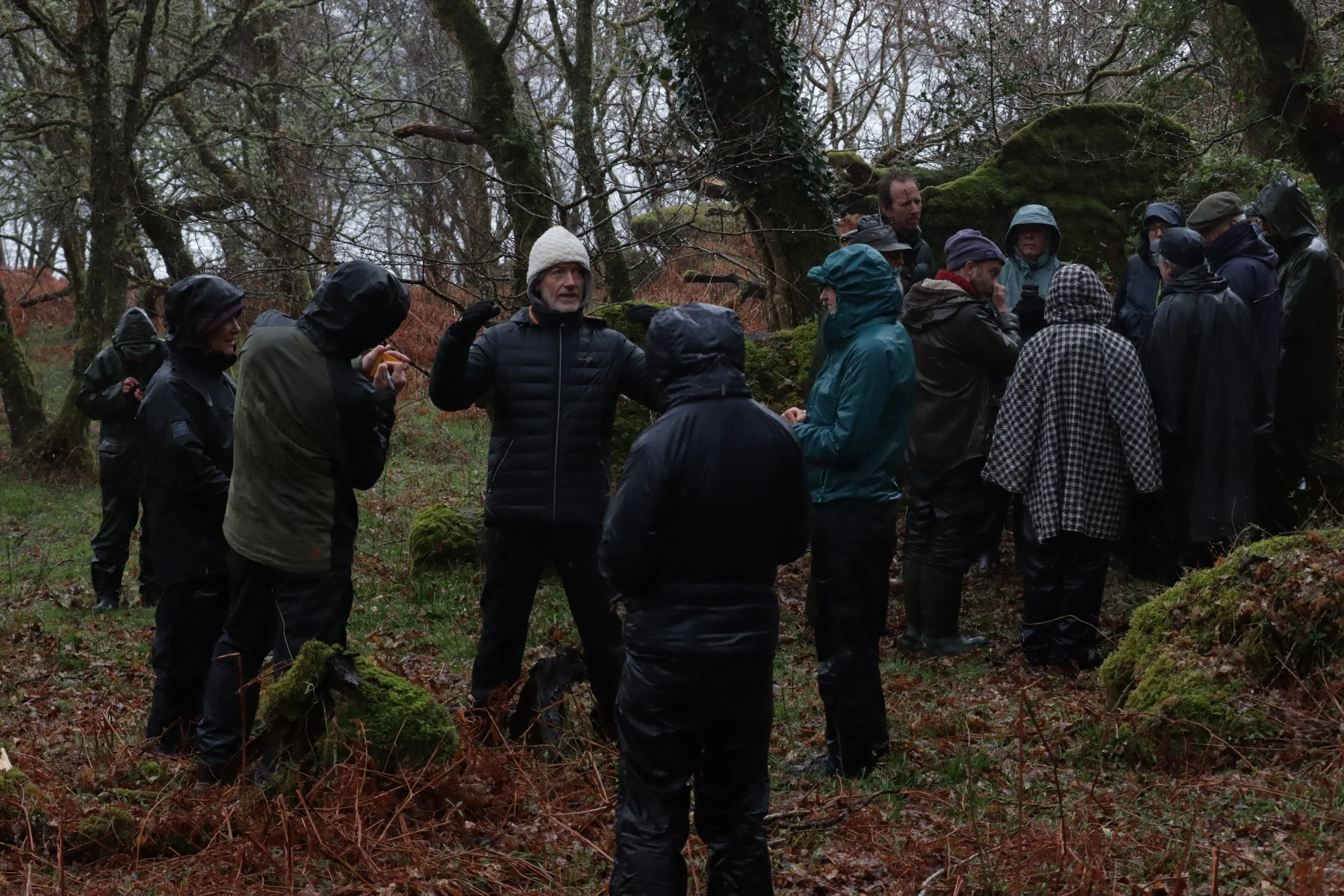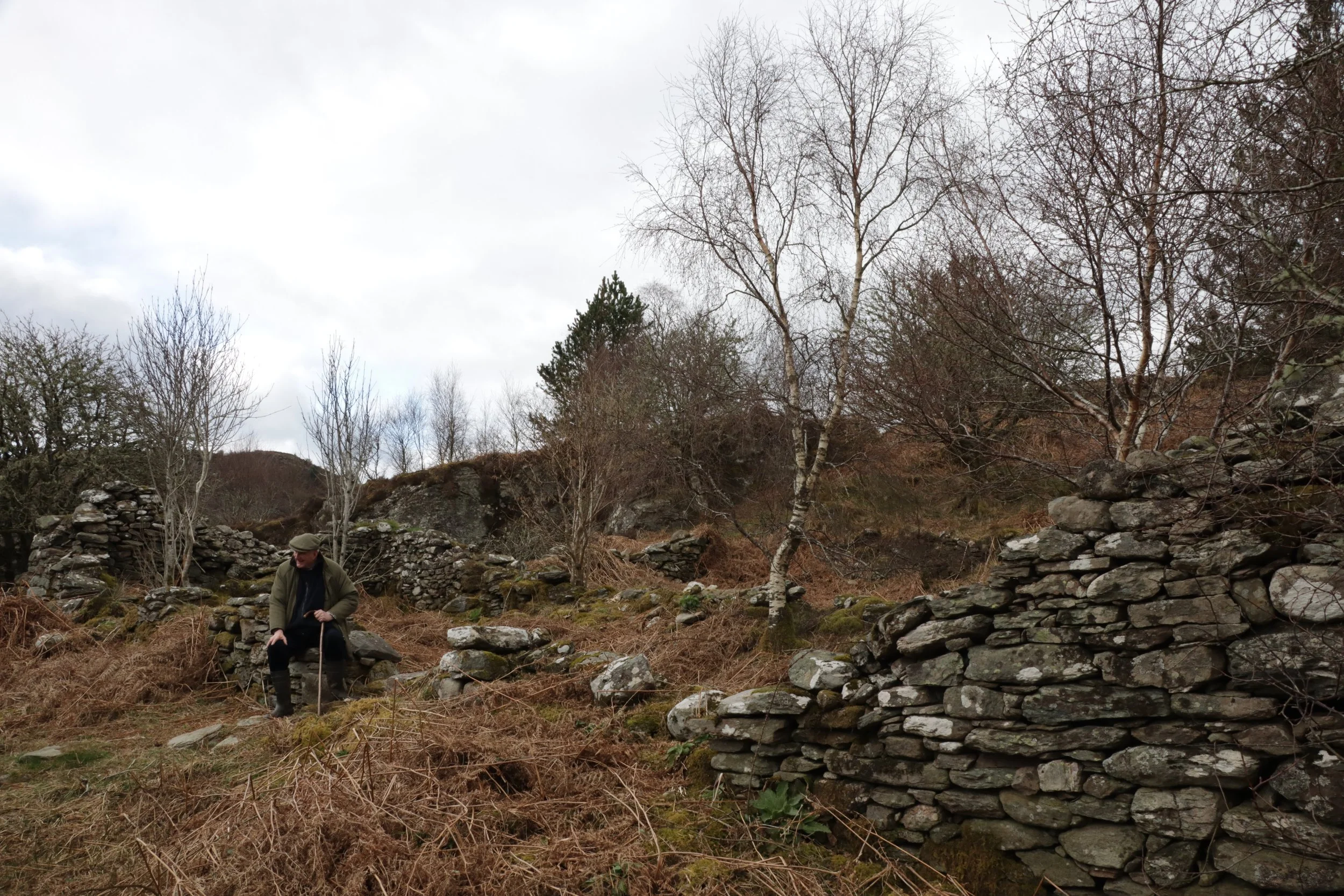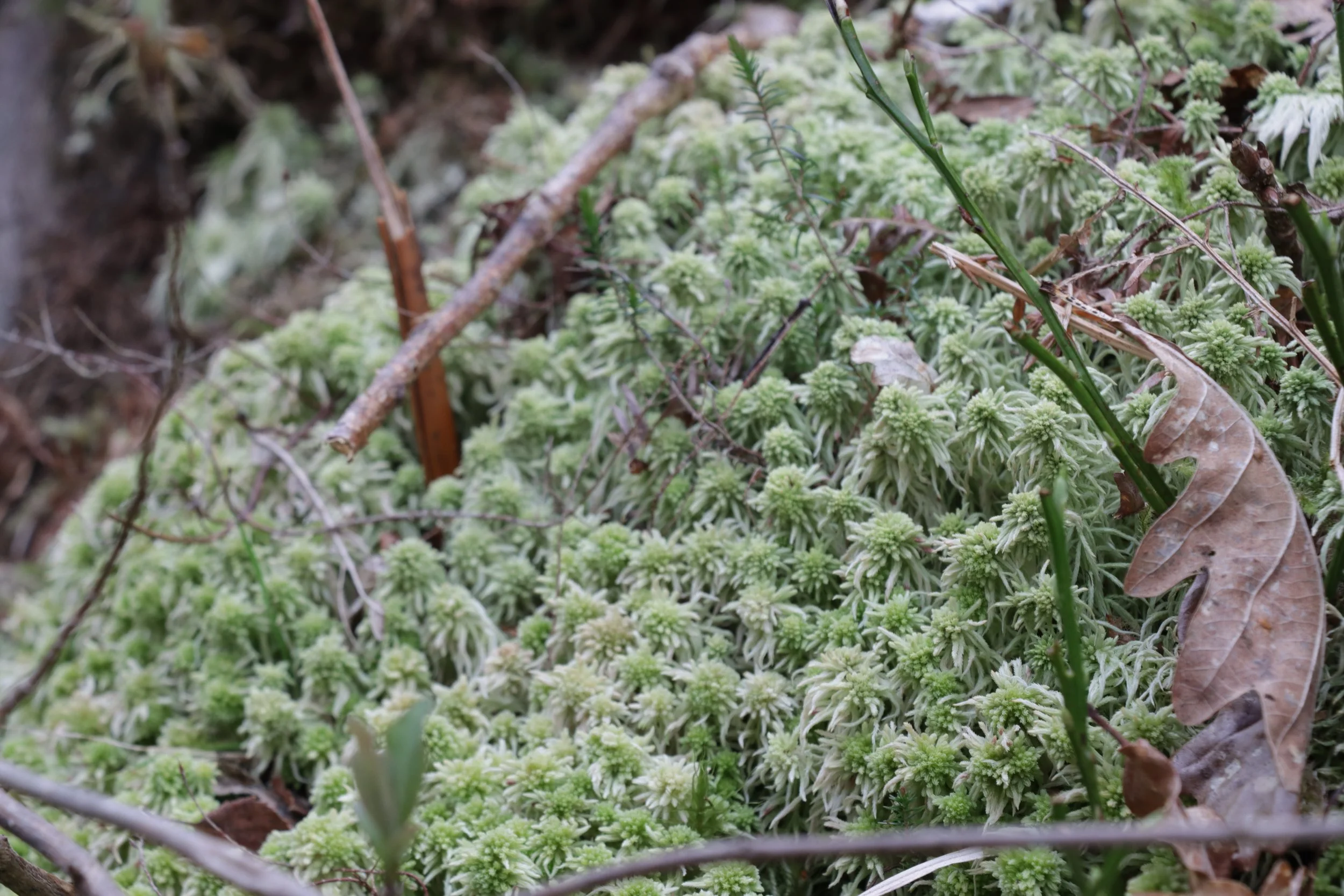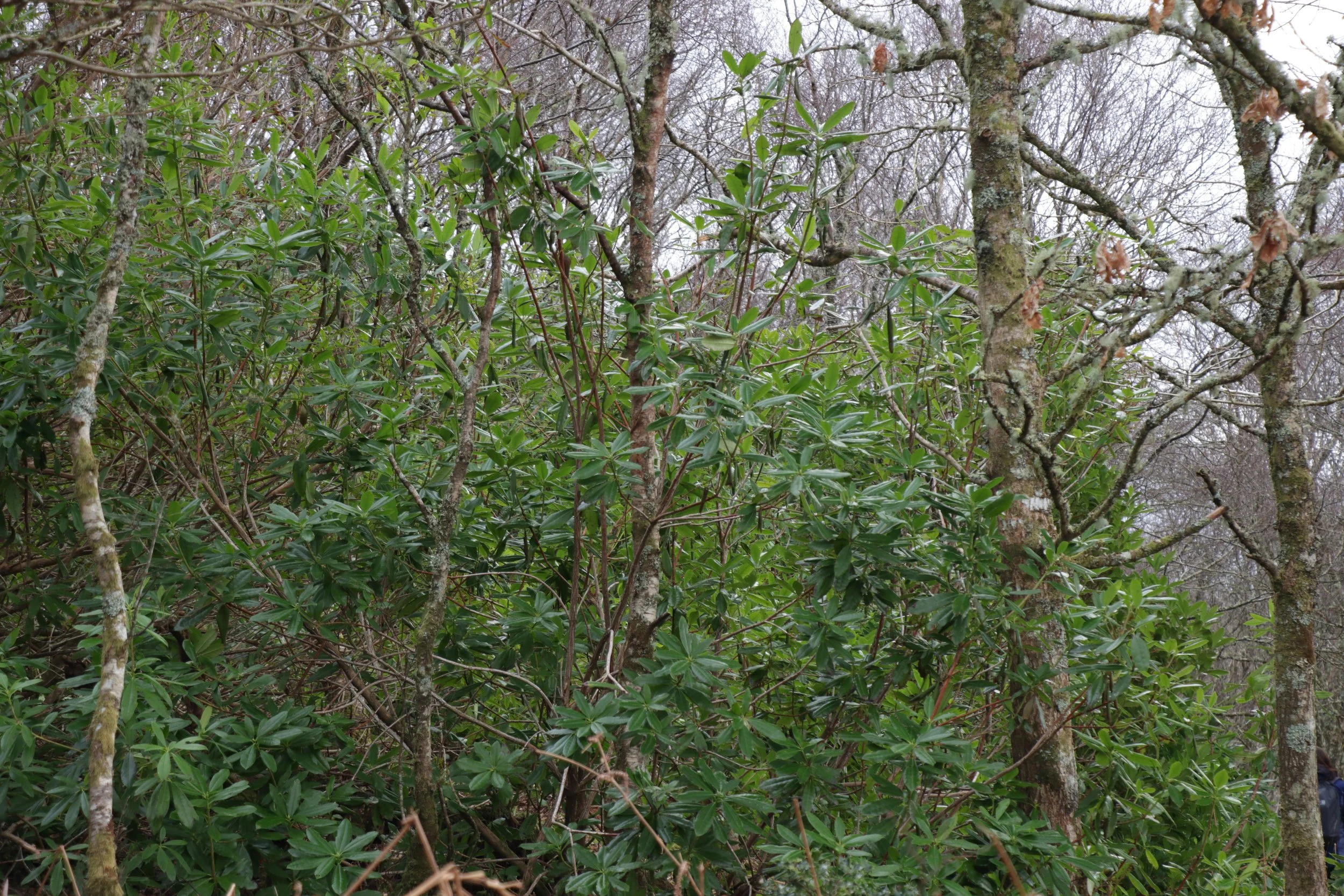Our 2025 Cause: Friends of Glenan Wood
Amongst the trees, mosses and lichens of native Scottish woodland, we huddled shoulder to shoulder with the group, our backs to the rain as it swept in off the Atlantic, engaged in discussion about the past, present and future of this special place. Tucked away at the Southern end of Argyll’s Cowal Peninsula, Glenan Wood very much embodied its classification as a temperate rainforest environment this late-winter afternoon, and while the weather was forecast to clear soon, the cold, wet start did little to dissuade the local community from turning up for this special event. Woodland ranger Rhyddian knight, and Friends of Glenan Wood trustee Hannah Buss, directed our attentions away from the rain, and towards the ecosystem around us which benefits so much from it. On behalf of BCC, we were here to begin work with the charity, Friends of Glenan Wood, and were intrigued to hear about the history of the area, the communities which had interacted so closely with the land here, and the threats which are to be mitigated against if this unique remnant of native woodland is to continue to thrive into the future.
Atlantic Temperate Rainforest is an incredibly rare ecosystem, so much so that the very presence of a rainforest in Scotland comes as a surprise to most people who first hear about it. That’s not to say that suitable environmental conditions are hard to come by - the vast stretch of coastline between Argyll in the Southern Highlands and Cape Wrath in the North, is prime environment for rainforest of this kind – but that so little of this is currently forested with native woodland. Only about 300km² of temperate rainforest remains in Scotland, and while these scattered fragments have survived social and environmental turmoil of past centuries, they continue to face threats from destructive herbivore populations, invasive plant species, and a lack of awareness hindering the extent to which such rare ecosystems might be represented in social and political spheres.
As we listened to Rhyddian and Hannah talk about the importance
of community
throughout Glenan’s history, . . .
. . we looked around at the present-day community who had donned their waterproofs and shrugged off the cold to be here today as part of this event. Glenan Wood, as of 2019, is community owned, with local people forming the board of directors and events like this organised specifically to encourage the wider community to be involved. Throughout the event, Hannah led the group in some mindfulness exercises, speaking about the astounding age of the rock, and rarity of the lichens and liverworts that dotted the diverse array of tree life. Once we had taken the time to fully appreciate the specialness of where we stood, and the forces of deep time and environmental momentum which had allowed the ecology here to flourish, Rhyddian stepped in to tell us of the small community of Glenan Village which had existed in coexistence with the rainforest before eventually being abandoned at the turn of the 20th Century.
Rhyddian read us excerpts from historical accounts of Glenan, sharing with us what he had learned from his research, and we couldn’t help but feel acutely aware of the role that a healthy community engagement with the land had played in retaining this fragment of native Scottish woodland.
The land that surrounds Glenan Wood is very much akin to the vast majority of the West Highland landscape, relatively empty expanses of hunting estates, extensive moorland inhabited largely by sheep, and dark tight rows of conifer plantation protected by deer fencing. Glenan seems to have avoided this fate by somehow avoiding the notorious Highland Clearances of the 18th and 19th centuries where communities throughout highland Scotland were driven from their remote villages to make way for widespread sheep farming. There is a growing body of evidence to suggest that this period of history marked a turning point in Scotland’s environment, and combined with the effects of the industrial revolution the native woodland population of Highland Scotland became vastly different to how it would have been previously.
Robin Webster
Sitting amongst the ruins of the last known settlement
The village of Glenan now sits abandoned, and the community who are taking the reigns as custodians of the woods are local to the nearby villages of Portavadie, Millhouse and Tighnabruaich.
Friends of Glenan Wood are working hard to organise events and initiatives to invigorate this custodianship and to give a voice to the adults and children of the local area to envisage a positive future for the forest. This is a priority of Friends of Glenan Wood, and one of the main tasks that Rhyddian takes the lead on. With this area of rainforest being community owned, there is a clear consensus that simply sustaining a healthy ecology here isn’t enough, community engagement is inseparable to the long-term wellbeing of the woodland. These woods have a history of coexistence with people, no doubt underpinned by an understanding and respect for the land, and it is important to Friends of Glenan Wood that the forest continues to receive visitors, both from the local area and from further afield.
Scotland’s progressive access laws ensure that anyone can visit Glenan Wood, and so there is a requirement to ensure that this freedom to roam does not negatively impact the forest itself. This means maintaining a basic path network, with scope for improvements, and ensuring that there is space to camp with the necessary information and facilities to accommodate larger groups. In addition to this there is a need to educate potential visitors that the rainforest environment here, while bursting with life and aged through centuries of continual growth, is a fragile environment and that such well established ecosystems cannot easily be brought back if they are damaged. Events like the one we attended in March go a step beyond this, speaking with community members who already know the importance of responsible access and encouraging their minds to a more contemplative place. Part of the event was dedicated to activities for the children of the local community, where they were encouraged to play and have fun in the forest, while understanding that it is a place of learning, where natural wonders can be found and ecosystems explored.
Hand in hand with inspiring future generations to enjoy and respect the forest is the need to protect it from more physical threats. A particularly intensive part of Rhyddian’s role here is to implement measures to protects the trees and lichens from an unrelenting invasive species to Scotland, Rhododendron Ponticum. There is a small presence of Rhododendron in Glenan Wood, but minimal in comparison to the amount seen in other wooded areas of the Cowal Peninsula. Land where the Rhododendron population isn’t properly managed, particularly in the wet, temperate region of Argyll, the plant can swamp the forests causing destruction of native trees and consequently the precious ecosystems throughout the understory. As well as working to remove this toxic plant species, Rhyddian has also been devising ways of turning the cut Rhododendron into charcoal, a far more elegant solution than simply letting the extracted plants go to waste.
Rhododendron Ponticum
Scotland's most threatening invasive non-native plant
Another problem endemic to Scotland’s forests is unmanaged deer populations, and this creates another seemingly endless task which demands much of Ryddian’s time. Despite being a native species, deer are highly problematic to the woodlands of Scotland as a whole - high fences and continual oversight are required if any piece of native woodland is to be protected from their grazing. Human intervention and poor land management throughout Scotland’s history has resulted not only in a booming population of deer, but an especially sedentary population which grazes at leisure through areas of land, irrespective of the young trees and lichen coverage that are destroyed in the process.
The preventative work of deer management, the removal of invasive plants, and the various community engagement initiatives, presents Friends of Glenan Wood with an ever-growing need for funding. Two years ago the board of directors secured a sum of funding substantial enough to employ Rhyddian Knight as the woodland ranger, and before long funding will once again be needed to continue the fantastic work that he does here. In addition, there is a plethora of running costs required to conserve the woodland and engage with the community, not to mention the costs involved for investing in a financially sustainable future for Glenan. Friends of Glenan Wood, since their conception, have championed an ethos of only accepting funds from organisations who truly want what’s best for the forest, and with this in mind they were delighted to learn that Big Canopy Campout very much share their vision for a flourishing community owned rainforest to be enjoyed by countless generations to come.
Big Canopy Campout aim to raise £5,000 for Friends of Glenan Wood this year, providing much needed funds to bolster the hard work already underway here.
To further encourage donations, and to help raise awareness of threatened ecosystems close to home, we are working with Rhyddian to host a very special Campout event in Glenan Woods in July. This will be the first time that our chosen cause has hosted one of our annual campout events, and we are excited to see what plans Rhyddian puts together to make the weekend one to remember.
In addition to donations, our bespoke BCC products have returned reinvigorated for 2025, with some changes made to the supply and ordering process to try and make things more manageable for everyone going into the future. The return of DMM products in BCC colours has been meet with a wave of enthusiasm, and our branded clothing with unique new designs are ready for sale and can be found on our website.
Preparations are well underway for us to attend Deutsche Baumpflegetage in Augsburg this month, as well as Arbor Berlin in June, where we will be selling many of our products in person. This will be a fantastic opportunity for us to engage directly with our incredible BCC community and to answer any questions or curiosities about this year’s cause or the annual campout event. If you’re attending either of these events then please do come by and say hello, we’re looking forward to being back amongst the wider tree climbing community once more, and to bring in a successful 2025 with Friends of Glenan Wood.











